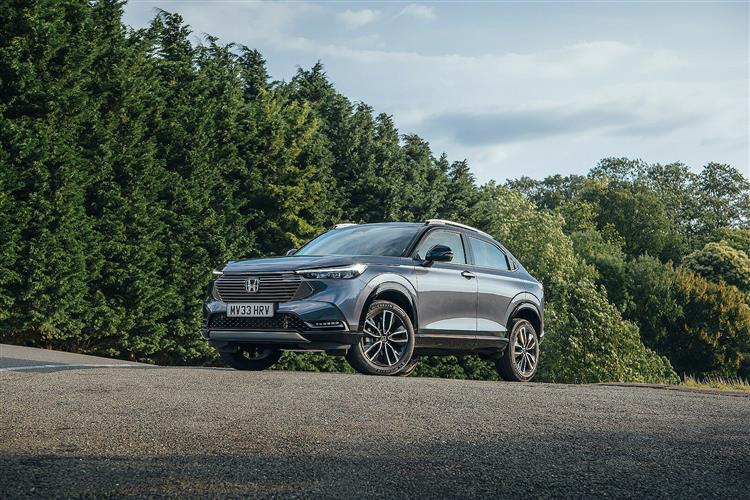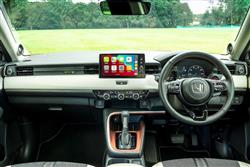How will you view?
This is a sample, showing 30 seconds of each section.
CLASSY LITTLE HYBRID HONDA (some text hidden) SECTIONED_new_hondahr-v_2022
By Jonathan Crouch
Introductionword count: 51
Back in 2021, the third-generation, full-Hybrid-only Honda HR-V brought its own formula to the small SUV-crossover segment. On the used market, it's more expensive than most competitors, and less roomy than some, but for customers prioritising cabin sophistication, interior flexibility and powertrain efficiency, it might well be worth the extra outlay.
Modelsword count: 9
5-door SUV [(1.5 Hybrid petrol) Elegance, Advance, Advance Style]
Historyword count: 357
Prior to 2021, the Honda HR-V hadn't previously set the world alight. The original version of 1999, dubbed by Honda the 'Joy Machine', was very much an outlier model - an oddball that back then appeared to be the answer to a question nobody had yet asked. In hindsight, perhaps this was simply a car that was ahead of its time, let down by a lack of marketing and an absence of the visual pizzazz that would characterise the segment-defining Nissan Juke eleven years later. It was a wasted opportunity, not least because when that original HR-V was withdrawn from sale in 2006, it wasn't replaced in Europe. By the time the successor model was eventually launched in 2015, the market had moved on dramatically and the small SUV/crossover segment was booming. Yet even after a far-reaching update in 2019, sales were relatively modest, partly because the MK2 design lacked the overtly fashionable looks of trendier segment rivals; partly because Honda price-positioned that car towards the top end of the small SUV sector; and partly because production numbers were limited by the Mexican factory's priority to satisfy the American market. In the meantime, the segment had grown considerably, with almost every brand by 2021 offering a model in this sector. There was by then more choice in how a small SUV or crossover could be propelled too: by this point in this class, diesel had become very much a niche option; customers were more likely to be choosing from petrol, mild hybrid, full-Hybrid and plug-in hybrid options. And this intensely competitive marketplace was where this third-generation Honda HR-V had to compete. But it did at least offer something different. As is often the case with Honda, the HR-V brought its own formula - a full-Hybrid-only SUV with fresh looks and what was claimed to be one of the most family-friendly and flexible interiors from a larger-than-class-average bodyshell. But it needed all these attributes because it was positioned at the upper price end of the segment. This MK3 HR-V was updated at the end of 2024, but it's the 2021-2024-era pre-facelift versions of it we look at here.
What You Getword count: 730
Here's a car that's very much of the moment - a crossover-SUV that combines this genre's higher stance with a raked rear window and design details likely to appeal to many customers in the market for a small-ish SUV offering a reasonable combination of practicality and panache. Although it shared its underpinnings and much of its engineering with Honda's Jazz supermini, the MK3 HR-V was, to all intents and purposes, a clean-sheet design. The smartest volume brand model in the segment from this period? We'd subscribe to that view; you may not. These things are subjective aren't they? If you're wondering why this Honda costs a little more than obvious rivals, get out your tape measure. It's 110mm longer than a Renault Captur E-TECH 145, 135mm longer than the Hyundai Kona Hybrid and a full 160mm longer than the Toyota Yaris Cross. At the wheel, anyone switching from the previous generation HR-V will feel they've jumped forward a decade. You might not mistake this for a premium brand model, but there's an impressive sense of calm and cohesion here, aided by the almost unbroken horizontal trim strip running across the front of the cabin, the centre of which is topped by a high-mounted 9-inch touchscreen. Horizontal vents stretch across the fascia just above it, while lower down, it's unusual to note that there's no centre stack: in its place, an unusual swirling strip, chrome-plated above base trim, encircles the gear lever, with storage areas above and below. Above entry-level trim, neat little vent controls at the corners of the dash offer a 'diffuse' setting, which promises to spread the air more evenly around the cabin. As usual on a Honda, the driving position's exemplary and everything falls instantly to hand. Looking through the steering wheel, there's an unusual combination of physical speedometer dial on the right and configurable information screen on the left. There are no configurable screen styles or GPS mapping options - just a whole list of ways you can display information in the left hand virtual dial. In the rear, there's certainly plenty of leg room, helped by a lot of space between the floor and the bottom of the front seats. In fact, there's 35mm more legroom than the previous HR-V provided, and the seats themselves are nicely contoured, though not super-supportive. The outer two positions are of course very much the preferred place to be - anyone seated in the middle will find themselves perched on a rather flat and raised cushion and reaching for belts integrated into the ceiling, though at least they'll have some leg space because of the flat floor and the positioning of the centre console. These rear seats don't slide or recline - but they are of Honda's 'Magic' variety, so feature the brand's party trick folding mechanism. That means the seat base can be flipped up towards the back of the car, cinema-seat-style, enabling taller objects - such as an electrical item or that tall plant you've purchased from the garden centre - to be carried behind the rear seats. Finally, let's consider the boot. If you remember the body length dimensions we mentioned earlier, you'll be expecting it to be segment-leading, so it comes as a bit of a surprise to find that the tailgate (power-operated above entry-level trim) rises to reveal one of the smaller trunks in the sector - 319-litres in size. At least the opening is wide and deep and the lip's pleasingly low, which should make is easy to move heavier or bulkier items in and out. It's a shame Honda didn't include either a ski hatch or a 40:20:40 seat back-split; as a result, if you've a couple of rear passengers, longer items will have to go on the roof. To drop the 60:40-split rear backrest, you'll probably have to go round to the side to operate the catches. Still, at least there, you'll be able to better appreciate the other advantage of that 'Magic Seat' folding mechanism we mentioned earlier. This neatly cantilevers the seat base when it folds so that you get a completely flat load area - though still not a very large one, the 987-litre figure 200-300-litres down on some rivals. In short, that useful seat flexibility costs you a little in capacity, but Honda owners will usually tell you that the trade-off in usability is well worth it.
To see the full road test text contact us on 0330 0020 227
Pictures (high res disabled)

.jpg)
|
.jpg)
|
.jpg)
| |||
.jpg)
|
.jpg)
|
.jpg)
| |||
.jpg)
|
.jpg)
|

|
Scoring (subset of scores)
Category: Crossover or SUV 4x4s
| Performance | |
| Handling | |
| Comfort | |
| Space | |
| Styling, Build, Value, Equipment, Depreciation, Handling, Insurance and Total scores are available with our full data feed. | |



